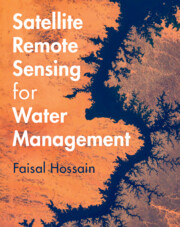Refine search
Actions for selected content:
690 results

Satellite Remote Sensing for Water Management
- Coming soon
-
- Expected online publication date:
- September 2025
- Print publication:
- 04 September 2025
-
- Textbook
- Export citation
10 - Communication leadership
- from Part 3 - Engages Others
-
-
- Book:
- Leading and Managing Health Services
- Published online:
- 15 August 2025
- Print publication:
- 28 August 2025, pp 110-121
-
- Chapter
- Export citation
29 - Leading and managing in the digital age
- from Part 5 - Drives Innovation
-
-
- Book:
- Leading and Managing Health Services
- Published online:
- 15 August 2025
- Print publication:
- 28 August 2025, pp 330-342
-
- Chapter
- Export citation
18 - Critical thinking and decision-making
- from Part 4 - Achieves Outcomes
-
-
- Book:
- Leading and Managing Health Services
- Published online:
- 15 August 2025
- Print publication:
- 28 August 2025, pp 200-209
-
- Chapter
- Export citation
21 - Financial management
- from Part 4 - Achieves Outcomes
-
-
- Book:
- Leading and Managing Health Services
- Published online:
- 15 August 2025
- Print publication:
- 28 August 2025, pp 233-247
-
- Chapter
- Export citation
31 - Strategic planning and sustainability
- from Part 6 - Shapes Systems
-
-
- Book:
- Leading and Managing Health Services
- Published online:
- 15 August 2025
- Print publication:
- 28 August 2025, pp 358-368
-
- Chapter
- Export citation
8 - Leadership and critical reflective practice
- from Part 2 - Leads Self
-
-
- Book:
- Leading and Managing Health Services
- Published online:
- 15 August 2025
- Print publication:
- 28 August 2025, pp 87-98
-
- Chapter
- Export citation
1 - Concepts of leadership and management in health services
- from Part 1 - Introduction
-
-
- Book:
- Leading and Managing Health Services
- Published online:
- 15 August 2025
- Print publication:
- 28 August 2025, pp 2-14
-
- Chapter
- Export citation
22 - Negotiating
- from Part 4 - Achieves Outcomes
-
-
- Book:
- Leading and Managing Health Services
- Published online:
- 15 August 2025
- Print publication:
- 28 August 2025, pp 248-256
-
- Chapter
- Export citation
11 - Leading interprofessional teams
- from Part 3 - Engages Others
-
-
- Book:
- Leading and Managing Health Services
- Published online:
- 15 August 2025
- Print publication:
- 28 August 2025, pp 122-130
-
- Chapter
- Export citation
26 - Building positive workplace cultures
- from Part 5 - Drives Innovation
-
-
- Book:
- Leading and Managing Health Services
- Published online:
- 15 August 2025
- Print publication:
- 28 August 2025, pp 287-300
-
- Chapter
- Export citation
30 - Workforce planning
- from Part 6 - Shapes Systems
-
-
- Book:
- Leading and Managing Health Services
- Published online:
- 15 August 2025
- Print publication:
- 28 August 2025, pp 344-357
-
- Chapter
- Export citation
13 - Partnering with stakeholders
- from Part 3 - Engages Others
-
-
- Book:
- Leading and Managing Health Services
- Published online:
- 15 August 2025
- Print publication:
- 28 August 2025, pp 142-154
-
- Chapter
- Export citation
32 - Health service planning
- from Part 6 - Shapes Systems
-
-
- Book:
- Leading and Managing Health Services
- Published online:
- 15 August 2025
- Print publication:
- 28 August 2025, pp 369-385
-
- Chapter
- Export citation
9 - Empathic leadership
- from Part 2 - Leads Self
-
-
- Book:
- Leading and Managing Health Services
- Published online:
- 15 August 2025
- Print publication:
- 28 August 2025, pp 99-108
-
- Chapter
- Export citation
25 - Successfully managing conflict
- from Part 5 - Drives Innovation
-
-
- Book:
- Leading and Managing Health Services
- Published online:
- 15 August 2025
- Print publication:
- 28 August 2025, pp 276-286
-
- Chapter
- Export citation
4 - Self-management
- from Part 2 - Leads Self
-
-
- Book:
- Leading and Managing Health Services
- Published online:
- 15 August 2025
- Print publication:
- 28 August 2025, pp 40-53
-
- Chapter
- Export citation
3 - Leading ethically
- from Part 2 - Leads Self
-
-
- Book:
- Leading and Managing Health Services
- Published online:
- 15 August 2025
- Print publication:
- 28 August 2025, pp 30-39
-
- Chapter
- Export citation
27 - Leading and managing change
- from Part 5 - Drives Innovation
-
-
- Book:
- Leading and Managing Health Services
- Published online:
- 15 August 2025
- Print publication:
- 28 August 2025, pp 301-315
-
- Chapter
- Export citation
17 - Holding to account
- from Part 4 - Achieves Outcomes
-
-
- Book:
- Leading and Managing Health Services
- Published online:
- 15 August 2025
- Print publication:
- 28 August 2025, pp 190-199
-
- Chapter
- Export citation
